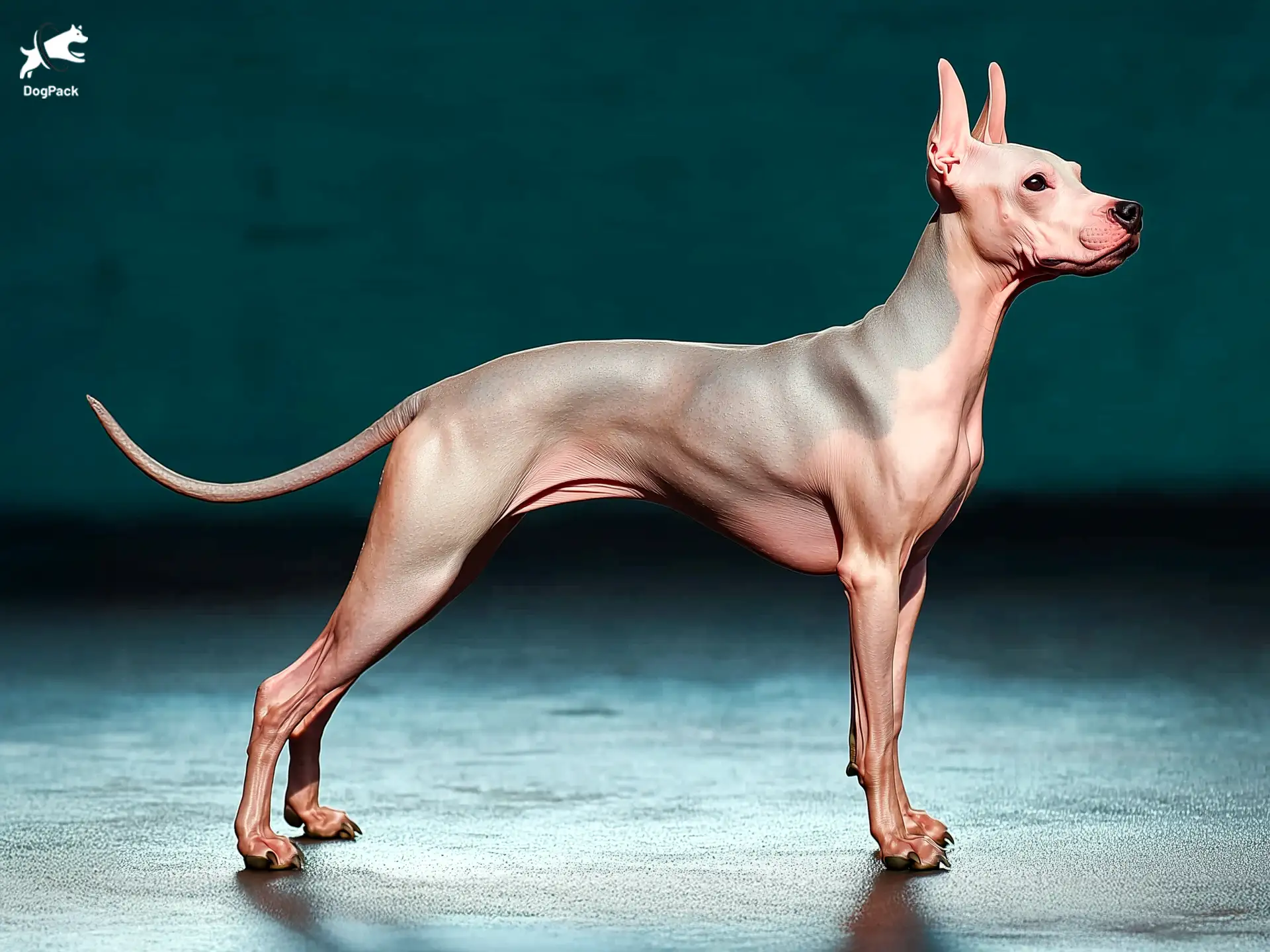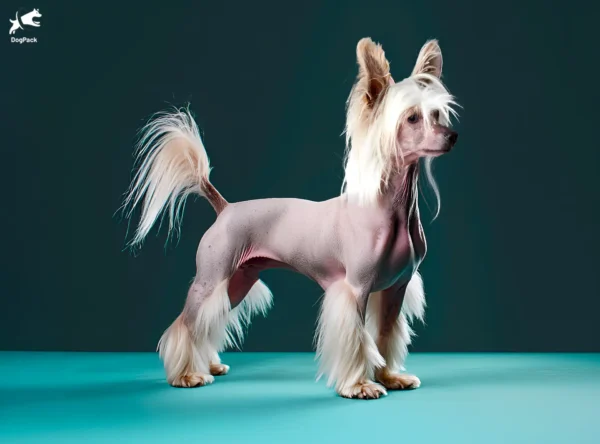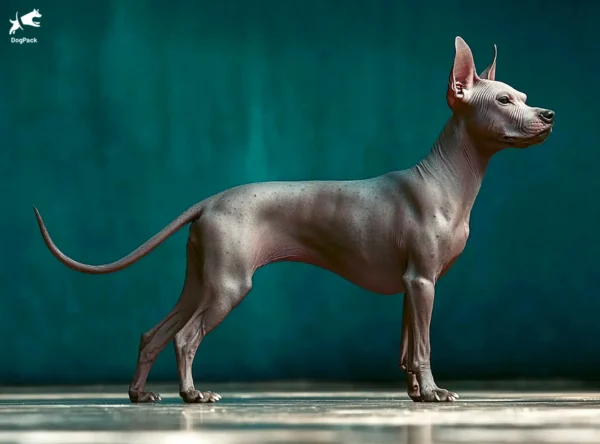Peruvian Hairless Dog Breed Info & Overview
The Peruvian Hairless Dog stands out for its nearly fur-free appearance and deep cultural roots. Known for its loving nature, this rare breed can vary in size, from small to large. While low-shedding, they have unique skin care needs, an agile build, and a playful, affectionate demeanor that makes them a captivating companion. They thrive in warm climates and form strong bonds with their families.
Characteristics
Pictures
Breed History
Archaeologists trace the origins of this fascinating companion back thousands of years, uncovering pottery and artifacts depicting hairless canines in ancient Moche and Chimu civilizations. These dogs were often held in high regard, sometimes even featured in ceremonial rituals. Over time, their iconic look and cultural significance led to them being cherished and preserved, making them a living piece of Peru’s storied past.
As Spanish explorers arrived in South America, the prominence of native dogs began to shift. Yet, local communities continued to appreciate the unique qualities of this hairless breed. The Peruvian Hairless Dog gradually found its place not only in rural homesteads but also in the hearts of those who sought a loyal guardian and companion. It survived centuries of changing traditions and regional influences.
Modern recognition of the breed sprang from a desire to preserve a national treasure. Peruvian canine organizations dedicated themselves to maintaining authentic bloodlines, with global kennel clubs eventually acknowledging their historical and cultural importance. Today, this breed is celebrated for its direct link to Peru’s rich heritage, serving as both a cultural icon and a delightful family pet, bridging ancient traditions with modern times.
Temperament, Personality
A warm and loving disposition shines through once this hairless companion trusts you. Often described as alert and attentive, it can be reserved around strangers at first. Early socialization ensures it becomes comfortable with unfamiliar faces and situations. With gentle guidance, it develops a friendly curiosity, making everyday life with this pup lighthearted and rewarding, despite that initial watchful nature.
Families often appreciate how this clever dog bonds closely with its favorite humans. It is known to follow its people around the house and may become mildly protective if it senses any threat. Children who treat it with respect will likely gain a gentle playmate. Because it’s affectionate, this breed thrives on companionship and tends to seek constant interaction with those it trusts.
When it comes to living with other pets, a gradual introduction is key. The Peruvian Hairless Dog can coexist peacefully alongside cats or fellow canines if properly socialized. Patience goes a long way, as it may need extra time to feel comfortable around new four-legged friends. Observing its signals and providing positive reinforcement will help nurture a harmonious multi-pet household.
Physical Characteristics
The first thing people notice is the dog’s nearly hair-free appearance. Some individuals have a tuft of hair on the head, paws, or tail, while others remain entirely bare. This lack of fur creates a sleek, distinct silhouette unlike any other breed. Beyond the hairless feature, its expressive eyes and upright ears contribute to a regal yet approachable look that captures attention everywhere it goes.
Beneath that smooth exterior lies a muscular, well-proportioned body. Agile and nimble, it moves with surprising grace, reflecting its heritage as an active partner in Peruvian culture. The skin itself can range in color, from dark grey or black to shades of copper or brown. Occasional spotting or mottling can appear, creating a unique pattern that makes each dog’s appearance one of a kind.
Though classified in varying sizes, most medium examples stand around 20 to 28 inches tall and weigh 50 to 75 pounds. Despite its slim frame, this breed can pack a remarkable level of athleticism and stamina. The Peruvian Hairless Dog has a balanced gait and a stance that conveys confidence, reflecting its centuries-old lineage. Its striking appearance often sparks curiosity wherever it roams.
Health Issues
This breed’s hairless trait comes with specific considerations. Skin sensitivities are common, making sunburn a real risk in harsh sunlight. Protective measures like canine-safe sunscreen or light clothing can help. Regular checks for dryness, rashes, or other irritation are vital since its bare skin is more exposed than coated breeds. Owners should consult a vet experienced with hairless dogs to develop a proper skincare routine.
Beyond dermatological concerns, joint health can be a factor for a dog that’s moderately active and fairly agile. Routine vet visits help detect early signs of hip dysplasia or patella luxation. Dental care is another area to monitor, as some hairless lines may have fewer or unusually placed teeth. Early examinations and consistent maintenance can prevent complications that could affect overall quality of life.
Though generally robust, it’s wise to watch for digestive sensitivities. Introducing new foods slowly can stave off tummy troubles. Keeping vaccinations and parasite prevention up to date further guards against common canine illnesses. Being proactive about health testing when working with a reputable breeder can limit inherited conditions. Ultimately, awareness of the breed’s special needs paves the way for a comfortable, healthy existence.
Grooming Needs
At first glance, you might assume a nearly hairless dog requires minimal upkeep. Surprisingly, its skincare demands can be as involved as brushing a fluffy breed. Because its skin is exposed, gentle baths and moisturizing lotions help maintain softness and prevent dryness. Harsh shampoos should be avoided. Instead, opt for mild, pH-balanced products recommended by a professional familiar with the Peruvian Hairless Dog.
Nails grow quickly and need regular trimming to keep paws comfortable. Ears should be examined weekly and wiped clean if debris gathers. While it may not shed in the traditional sense, a light exfoliation session using a soft cloth or dog-safe mitt can remove dead skin cells. This routine helps avoid buildup and promotes healthy circulation, keeping that smooth surface vibrant and free of irritation.
Owners often find the grooming process to be a bonding experience. Because this breed can be sensitive, introducing it to bathing and skincare at a young age makes the ritual more pleasant. Reward-based methods, calm handling, and patience reduce stress and build trust. Over time, a consistent approach to grooming leads to a relaxed pup that doesn’t resist these essential steps for overall well-being.
Exercise Requirements
Despite their sophisticated appearance, these dogs love to move. A brisk daily walk or jog keeps them in shape, and they relish games like fetch or tug-of-war. Varying the routine helps stave off boredom, which can lead to restlessness or minor mischief. Due to their heritage, they adapt well to moderate outdoor exploration, although you’ll want to protect that exposed skin in cooler or sunnier weather.
Providing mental stimulation can be just as important as physical exertion. Puzzle toys or nose work exercises challenge their intellect while satisfying curiosity. The Peruvian Hairless Dog thrives on fresh experiences, so rotating activity spots and incorporating new games fosters a well-rounded, content companion. Always monitor for signs of fatigue or overheating, especially in intense climates, and adjust the exercise schedule accordingly.
Social play with other canines offers another healthy outlet for energy. Friendly dog parks or organized playdates let them burn off steam while refining social skills. Encouraging varied activities also strengthens the bond between dog and owner. With thoughtful planning, regular exercise, and creative engagement, this breed remains physically fit, mentally stimulated, and ready to snuggle up for a well-deserved rest afterward.
Training Tips
Patience and consistency are crucial for coaxing out the best behavior in a Peruvian Hairless Dog. These canines can be sensitive to harsh treatment, so using positive reinforcement yields superior results. Reward-driven methods with treats or praise keep them motivated and focused. Short, varied training sessions work best, as they can grow bored if asked to repeat the same drills over and over.
Early socialization is key to curbing any wary tendencies toward strangers. Introduce your pup to new sights, sounds, and smells in a controlled, friendly manner. Gradual exposure helps them blossom into a well-rounded companion. They’re naturally observant, so demonstrating calm leadership can instill confidence. Once they feel secure, you’ll notice how quickly they pick up new commands and delight in pleasing their family.
It’s helpful to maintain a regular schedule—consistent mealtimes, daily walks, and designated quiet hours. Over time, these predictable routines help reinforce good habits. Should any behavioral hiccups arise, address them immediately with gentle redirection. Enrolling in an obedience class or seeking professional guidance is never a bad idea, especially if you want your hairless companion to master advanced tricks or specialized tasks.
Nutrition, Diet
Feeding a Peruvian Hairless Dog calls for careful attention to skin-friendly nutrients and calorie intake. Opt for a balanced diet with moderate protein levels and essential fatty acids that promote healthy skin. Cooked fish like salmon or sardines can be an excellent supplement once or twice a week, as they’re rich in omega-3s. Avoid common allergens like wheat or soy, which might aggravate dermatological issues.
Adult dogs weighing around 50–75 pounds often do well on two evenly spaced meals daily, each portion ranging from 1.5 to 2 cups of high-quality kibble or a veterinarian-approved raw diet. Some individuals have faster metabolisms, so portion sizes may need occasional adjustments. Monitor weight and overall condition regularly, and consult a vet if you notice excessive thinning, weight gain, or persistent digestive issues.
Because skin health is paramount, you may consider dietary supplements like fish oil capsules or flaxseed oil if recommended by a trusted professional. Hydration also plays a role, so ensure fresh water is always available. When introducing new foods, observe closely for any signs of allergic reactions or discomfort. A well-tailored meal plan directly supports the dog’s energy levels, coat condition (where present), and overall vitality.
Adoption, Breeders
Seeking out a Peruvian Hairless Dog involves due diligence. Reputable breeders focus on healthy bloodlines with stable temperaments. They provide health clearances and welcome questions about the dog’s lineage. Visiting the facility allows you to see the parents’ living conditions and temperament firsthand. Since this is a rare breed, patience is key; waiting lists are common to ensure responsible breeding practices.
For those interested in adoption, specialized rescue organizations sometimes have retired show dogs or individuals who need a second chance. Search local shelters, breed-specific rescue groups, or online databases. Ensuring you find a match that suits your lifestyle can lead to a rewarding relationship. The American Kennel Club (AKC) or Peruvian Hairless Dog clubs often list reputable breeders and rescue resources.
Verify that any group you contact follows ethical guidelines and prioritizes the dog’s welfare. Inquire about health screenings, socialization efforts, and post-adoption support. Legitimate breeders or rescues will happily answer questions and even offer lifelong advice. By choosing a responsible path—be it through a breeder or rescue—you increase the likelihood of finding a well-adjusted companion that fits seamlessly into your home.
Family Pet?
Many families find that a Peruvian Hairless Dog brings an extra dose of warmth and loyalty. Its playful spirit keeps children entertained, provided they treat the dog gently. In a household setting, this sensitive pup can form deep attachments, following family members from room to room. Its tendency to be protective means it may sound an alarm at unfamiliar noises or guests.
While energetic enough to keep up with older kids, small children should be taught respectful handling to avoid accidental scratches or stress for the dog. This breed’s alert nature can work in your favor, especially if you value a watchdog that barks at potential intruders. However, proper socialization is essential for smoothing out any overprotective instincts that might emerge in a busy home environment.
Because it bonds so strongly, the Peruvian Hairless Dog appreciates a family that offers both companionship and a structured routine. Leaving it alone for extended periods might lead to mild anxiety or restless behaviors. If you can provide a warm, safe space—plus plenty of positive interactions—this breed often thrives and becomes an endearing family member, forging an especially close connection with those it trusts most.
Right For You?
If you’re drawn to an uncommon breed with a striking look and a big heart, this may be the dog for you. Owners who enjoy moderate exercise, attentive grooming, and a unique bonding experience typically find it rewarding. If you live in a colder climate, be prepared for extra skin protection and warmth during chilly months. A mindful approach to care suits this loyal companion perfectly.
Those with allergies will appreciate its low-shedding nature, though dedicated skincare is a must. Families who value a tight-knit bond and can offer consistent interaction often thrive with this breed. On the other hand, individuals seeking a low-maintenance dog might find the daily skin checks and specialized diet a bit intensive. Reflect on your available time, resources, and willingness to adapt before making a final decision.
Conclusion
If you adore a loyal, culturally significant companion with minimal fur and a gentle nature, the Peruvian Hairless Dog could be your perfect match. Attentive skincare, regular checkups, and sensible exercise ensure a long, happy life for this remarkable pup. By embracing its unique needs—and appreciating its storied heritage—you’ll gain a devoted friend who stands out in every possible way.
FAQs
-
Why does the Peruvian Hairless Dog have such warm skin to the touch?
The Peruvian Hairless Dog often feels unusually warm because its lack of fur allows direct heat dissipation from the body. This natural warmth once led ancient Peruvians to use them as living heating pads for joint pain.
-
Can the Peruvian Hairless Dog get sunburned easily?
Yes, the Peruvian Hairless Dog is prone to sunburn due to its exposed skin. Owners should apply dog-safe sunscreen or use protective clothing during prolonged sun exposure to prevent irritation.
-
Is the Peruvian Hairless Dog naturally odorless compared to other breeds?
The Peruvian Hairless Dog is known for having a remarkably low odor. With no fur to trap oils or debris, they tend to stay cleaner and smell fresher than most coated breeds, even between baths.
-
Did the Peruvian Hairless Dog have spiritual significance in ancient cultures?
Yes, the Peruvian Hairless Dog held sacred status among pre-Columbian civilizations. They were believed to have healing powers and often appear in ancient Peruvian pottery and burial sites.
-
What’s the rare coated variety of the Peruvian Hairless Dog called?
The Peruvian Hairless Dog also comes in a rare coated variety, which has a short, fine layer of fur. Though less known, it’s still officially recognized in breed standards and born occasionally within litters.
Breed Ratings
The Peruvian Hairless Dog is quick to grasp new commands, responding well to kind, consistent training.
This spirited canine enjoys games and interactive fun, especially with a favorite human by its side.
Moderate to high; daily activities keep it engaged, but it won’t climb the walls if you miss a session.
With virtually no fur, shedding is minimal, making upkeep far simpler than fully coated breeds.
Generally low, though a curious streak might prompt the occasional chase after a small critter.
Special skin care is required, but overall grooming time is reduced compared to long-haired breeds.
Positive reinforcement methods yield excellent results, reflecting its eagerness to learn.
Prefers consistent companionship and may become anxious if isolated for extended periods.
Tends to alert owners to unusual noises but isn’t excessively vocal once it feels secure.
Rarely a concern, thanks to its sleek muzzle and lack of heavy jowls.
Can do well with others if introduced properly and socialized early.
Generally robust with proper skin care, but attention to joints and dental health is crucial.













